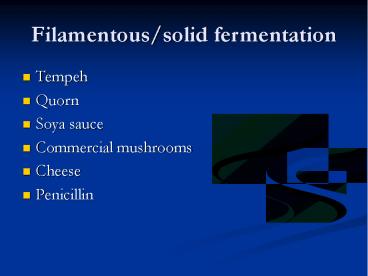Filamentous/solid fermentation PowerPoint PPT Presentation
Title: Filamentous/solid fermentation
1
Filamentous/solid fermentation
- Tempeh
- Quorn
- Soya sauce
- Commercial mushrooms
- Cheese
- Penicillin
2
Agricultural waste
- 2.1 x 1012 kg per year
- cereal straw, sugarcane and sugar beet residue
- primarily cellulose and lignins
- low digestibility (40-60) even for herbivores
- subsistence nutrition
- leads to low growth rates, and need for feed
supplements (especially lysine!)
3
Tempeh traditional
- Used for food and feed
- Modifying agricultural waste ? materials that do
not have economic value by direct use, or for
conversion by animals into valuable products - Undigestible carbohydrates are wrapped in large
leaves (banana) and left 1-2 d for solid
fermentation - Mixed inoculum of wild fungi
4
Tempeh food
- Tempeh Rhizopus oligosporus
- Soya beans or other plant material
- Uses similar to tofu
5
Quorn mycoprotein
- Fusarium graminearum A3/5
- 1964 RankHovisMcDougall (RHM) ? high-protein
foods from starch - Highly branched colonial mutant CC1-1 that
arose spontaneously in a glucose-limited culture
of F. graminearum (now called F. venatum) - Unlike tofu, has a meat-like texture, chewiness,
mouthfeel - January 1985 marketed in England
- Vegetarianism Mad cow disease
- February 2002 marketed in USA
- http//www.cce.cornell.edu/food/fsarchives/050602/
quorn.html
6
Culturing Fusarium graminearum A3/5
- Isolated from soil, UK
- Liquid fermenters stirred and cooled
- Oxygen, nitrogen, waste soluble carbohydrates,
and vitamins - RNA-reduction process debittering improves
digestibility - Current annual production 14,000 tons
- between chicken and mushroom in texture, with
very little inherent flavor
7
Quorn mycoprotein ? publicity
- Quorn fillets are made from succulent mushroom
protein, coated in light crispy batter - like mushrooms, truffles and morels
- hails from the fungi family
- deliver unrivaled taste, as well as an
exceptional nutritional profile. - excellent source of protein and fiber
- cholesterol free low in fat, especially
saturated fat
8
Single Cell Protein technology
- Toprina animal feed 1970s
- Candida lipolytica cultivated on C15 n-alkanes
- initially at Grangemouth (Scotland) later
production scale in Sardinia - significant feature ? hydrocarbon was completely
fermented - protein content 65
- production uneconomic due to cost of cooling the
fermenters
9
Soya sauce, miso, tamari
- Soya bean wheat flour Aspergillus
- ? Koji mold
Sprinkled over toasted wheat flour
Steamed soya beans Cooled
Sprinkled with Aspergillus sojae
10
Soya sauce, miso, tamari
- Three days of aerobic fermentation
- Cool temperature to prevent bacterial overgrowth
- Transferred to barrels
- Brine added to 15 salt
18 months
11
Soya sauce, miso, tamari
Liquid soya sauce Solid miso and
tamari Further maturation ? up to several
months, cool temperature
12
Tempeh
- Soybeans are boiled and dehulled
- Rhizopus oligosporus grows lt 24 h, creating a
solid cake of hyphae/beans - Soybeans are made more digestible by lipases and
proteases secreted by Rhizopus,as well as fungal
components - Growth is halted (cooking, freezing) before
sporulation begins (NB oligosporus few spores - Traditionally, tempeh is stored wrapped in banana
leaves, and eaten soon after preparation
13
Modified forage
- 2.1 x 1012 kg per year cereal straw, sugarcane
and sugar beet residue contains nutrients,
primarily as cellulose and lignins - low digestibility (40-60) even for herbivores
- generally subsistence nutrition, but leads to low
growth rates, and need for feed supplements - uses naturally occurring fungi, /or inoculated
deliberately
14
Basic Mushroom culture
- Grow spawn on grains
- Inoculate substrate
- Mycelial growth in substrate
- Fruiting, harvest, grading
15
Commercial mushroom growing
- Agaricus brunescens
Crimini (Italian brown)
3-7 d
16
Commercial mushrooms
- Pleurotus ostreatus oyster mushroom straw,
sawdust, bagasse and molasses (from sugar
refining)
17
Commercial mushrooms
- Shiitake Lentinus edodes
- Inoculated into oak logs
18
Commercial mushrooms
- Enoki
- Flammulina velutipes
http//www.mykoweb.com/CAF/species/Flammulina_velu
tipes.html
19
Commercial mushroom harvest wild mushrooms can
save the forest
- Morchella, Cantharellus
Value to the forest , mycorrhizae,
environmental monitoring
20
Morels in truffle juice 50g 11.60
Boletus granulatus, Tricholoma terreum, Lactarius
deliciosusGuaranteed freshly picked up 200g
3.95
Boletus edulis 200 g 6.98
http//www.lefruitier.com/provence-shop/catalog_pr
oducts_with_images.php
21
Cheese manufacture
- Fungi ? flavour and texture ONLY
22
Roquefort
Sheeps milk ? Penicillium roquefortii
23
Roquefort productionwww.frencheese.co.uk
- traditional cheese-making process
- genuine Roquefort cheese ? look for the red sheep
seal on the packaging - sheeps milk is shipped to the cheese-making
facilities in 40 liter containers, rather than
tanker trucks, to avoid breaking up the milk-fat
on the way - milk is tested and filtered, but neither
pasteurized nor homogenized - prepared with rennet for two hours
- whey is drained ? curds are hand-ladled into
draining molds
24
Roquefort productionwww.frencheese.co.uk
- whey is drained ? curds are hand-ladled into
draining molds - Penicillium roqueforti culture is added (same
culture used to make English Stilton) - P. roqueforti grown by leaving bread in the caves
for six to eight weeks until it was consumed by
the mold ? crumb was then dried to produce a
powder - finished cheeses are stored for a week and
turned frequently - moved to the caves of Cambalou
- salted and pierced to encourage the growth of the
mold - aged in the caves at least three months
25
Blue cheese options
26
The story of penicillin the contaminant that
changed history
- Alexander Fleming Staphylococcus aureus
- Contaminated plate showed a zone of inhibition
Original culture was Penicillium notatum
27
Development of submerged fermenters for aerobic
fungi
Industrial development was moved to Illinois to
protect from WWII (Chain and Florey) Original
culture lost reisolated modified and
selected ? P. chrysogenum and submerged culture
28
Bacillus penicillin
Bacillus
29
Antibiotic resistance
40,000 units total ? 500,000 per day typical
treatment 20 million kg antibiotics / year in US
70 used in agriculture

